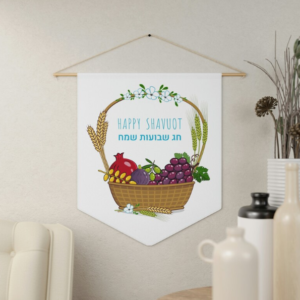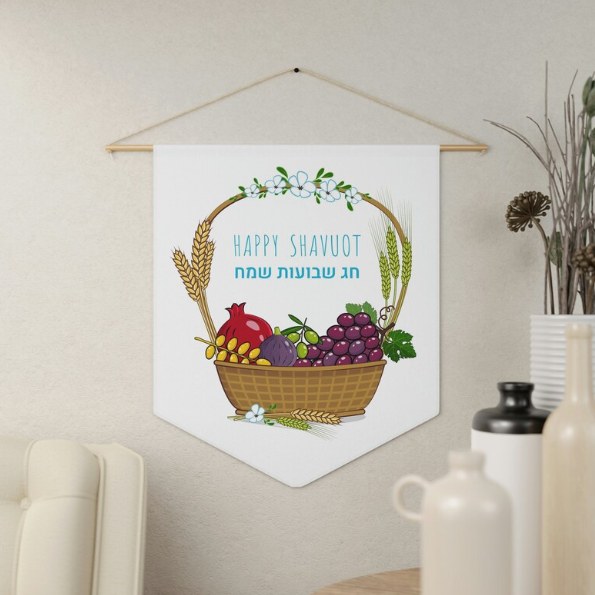1. The Concept of First Fruits
Chag Bikkurim is the Festival of the First Fruits. Historically the Jews would make pilgrimage to Jersusalem bearing a gift offerings the first fruits of their land, in particular the seven kinds with which the holy land was abundantly blessed. At the same time the national economy could not survive on grain and furit offerings the wealthy landowners would bring their gifts in baskets of silver and gold. In an agrcultural economy Shavuot was a time of great bounty, of joy and and occasion for the nation to come together to give thanks.
Want to understand What is Shavuot? Read our page on the basics of Shavuot and some of the most asked questions about this holiday. What is Shavuot and most asked questions

Shavuot First Fruits holds a deep-rooted significance within Jewish tradition, reflecting the agricultural and spiritual aspects of the holiday. In ancient times, the concept of first fruits involved offering a portion of the initial harvest to God as an expression of gratitude and acknowledgement for the abundance provided by the land.
B. Biblical Commandments and First Fruits The practice of presenting first fruits to God is traced back to the biblical commandments found in the Torah. These commandments instructed the Israelites to bring their first and best produce to the Temple in Jerusalem during the festival of Shavuot. By doing so, they would demonstrate their devotion, trust, and recognition of God’s role as the ultimate provider.

C. Symbolism of Dedicating the First and Best The act of offering the first fruits carries profound symbolism. It represents an acknowledgment of God’s sovereignty over the land and the cycle of life. By dedicating the initial and finest produce to God, individuals and communities express their trust that God will continue to bless and sustain them throughout the harvest season and beyond.
D. Gratitude and Recognition of God’s Provision The presentation of first fruits is imbued with gratitude and serves as a reminder to appreciate the blessings bestowed upon us. It encourages a sense of mindfulness and thankfulness for the abundance of the earth and the sustenance it provides. This act of recognition encourages a deeper connection to nature and an understanding of our interdependence with the world around us.
Shavuot Table Runners for the Harvest Celebration
2. Rituals and Customs of Shavuot First Fruits
Traditional Practices Associated with Shavuot First Fruits Shavuot First Fruits is celebrated through a variety of rituals and customs that have evolved over time. While some practices may vary among different Jewish communities, several elements are commonly observed.
B. Bringing the Bikkurim (First Fruits) to the Temple In ancient times, one of the central practices of Shavuot First Fruits involved bringing the Bikkurim, or the first fruits of the harvest, to the Temple in Jerusalem. People would carefully select the choicest produce, typically wheat or barley, and present it as an offering to God. This act symbolized the acknowledgment of God’s role as the provider of the land’s abundance.
C. Modern-Day Customs: Flowers, Greenery, and Dairy Foods In contemporary celebrations of Shavuot First Fruits, certain customs have emerged. Homes and synagogues are adorned with flowers and greenery, representing the beauty of nature and the flourishing of the land during the harvest season. This decoration serves as a visual reminder of the agricultural origins of the holiday.

Additionally, a unique custom associated with Shavuot is the consumption of dairy foods. People indulge in dishes such as cheesecakes, blintzes, and other dairy-based delicacies during this holiday. The reasons for this tradition vary, with some explanations suggesting a connection to the “land flowing with milk and honey” mentioned in the biblical texts, while others highlight the symbolic association between the Torah, often described as nourishment for the soul, and dairy products.
D. Embracing Universal Themes While the specific customs surrounding Shavuot First Fruits may vary, the underlying themes and principles resonate beyond the Jewish community. The act of presenting first fruits reflects a universal practice of expressing gratitude, recognizing the interconnectedness of humans and nature, and cultivating a sense of abundance and sharing.
Moreover, the emphasis on gratitude and acknowledgment of blessings extends to the wider audience. Regardless of religious affiliation, Shavuot First Fruits offers an opportunity to reflect on the importance of recognizing and appreciating the gifts in our lives. It serves as a reminder to express gratitude for the sustenance we receive, be it physical nourishment, relationships, or personal achievements.
In essence, the rituals and customs associated with Shavuot First Fruits capture the essence of the holiday’s agricultural and spiritual roots. Whether through the ancient practice of offering first fruits at the Temple or the modern-day observances of adorning spaces with flowers and enjoying dairy delicacies, these customs foster a deeper connection to nature, gratitude, and a celebration of the abundance found in our lives.



3. Shavuot First Fruits in Contemporary Times
A. Celebrating Shavuot First Fruits in Modern Jewish Communities In present-day Jewish communities, the celebration of Shavuot First Fruits continues to hold significance, albeit with adaptations to reflect the realities of modern life. Synagogues and communal organizations organize special services and gatherings, bringing together individuals and families to commemorate the holiday.
These celebrations often include readings from the Torah, prayers, and songs that highlight the themes of gratitude, abundance, and the importance of Torah study. Community events may also feature educational programs, lectures, and discussions on topics related to agriculture, sustainability, and the interconnectedness between nature and spirituality.
B. Diverse Interpretations and Adaptations Shavuot First Fruits is celebrated across various Jewish denominations, each offering unique interpretations and adaptations of the holiday. Orthodox communities often maintain traditional practices, including the reading of specific biblical passages and the recitation of ancient liturgical texts.

In contrast, Reform and Conservative communities may incorporate more contemporary elements into their celebrations. They might engage in creative interpretations of the holiday’s themes and focus on social justice initiatives, connecting the values of Shavuot First Fruits with modern-day challenges such as environmental stewardship and supporting local farmers.
C. Relevance in Today’s Contexts Despite the shift from primarily agrarian societies to urbanized environments, Shavuot First Fruits remains relevant in contemporary times. While fewer people engage directly in agricultural activities, the holiday serves as a reminder of our dependence on the earth’s resources and the importance of sustainable practices.
Shavuot First Fruits also holds broader significance beyond the Jewish community. Its core themes of gratitude, abundance, and acknowledging blessings resonate with individuals of diverse backgrounds and beliefs. The principles of recognizing and appreciating the goodness in our lives and cultivating a sense of interconnectedness with the world around us are universal and timeless.
D. Gratitude, Abundance, and Sharing Blessings At its essence, Shavuot First Fruits invites us to embrace an attitude of gratitude, recognizing the abundance in our lives and expressing appreciation for the gifts we receive. It encourages us to pause and reflect on the interconnectedness of nature, spirituality, and community.
Whether through traditional practices or contemporary adaptations, Shavuot First Fruits offers a meaningful opportunity for individuals to connect with their heritage, engage in acts of kindness and charity, and deepen their appreciation for the blessings that enrich their lives.
In summary, Chag Habikkurim, also known as Shavuot First Fruits, is a Jewish holiday that holds deep significance in both agricultural and spiritual contexts. It originated in ancient times as a festival marking the end of the barley harvest and the beginning of the wheat harvest. It is celebrated on the holiday of Shavuot, which also commemorates the Israelites’ receiving of the Torah at Mount Sinai.











